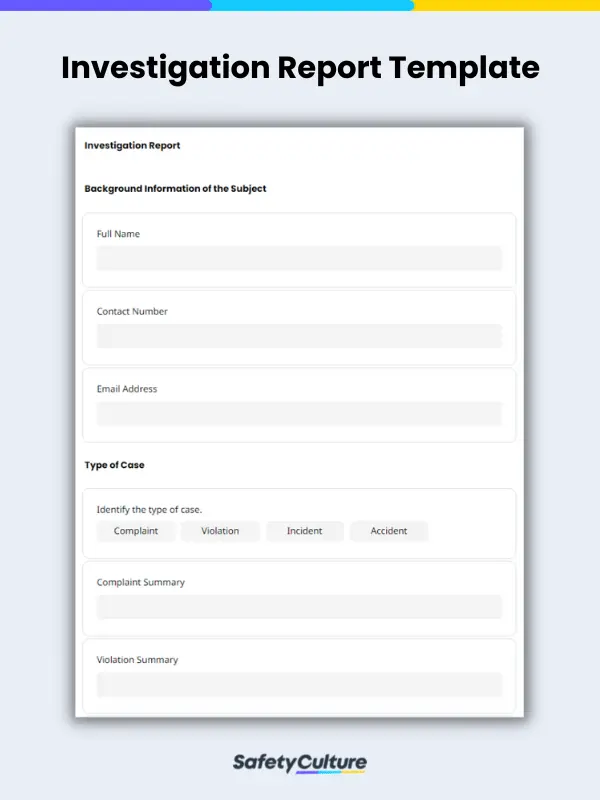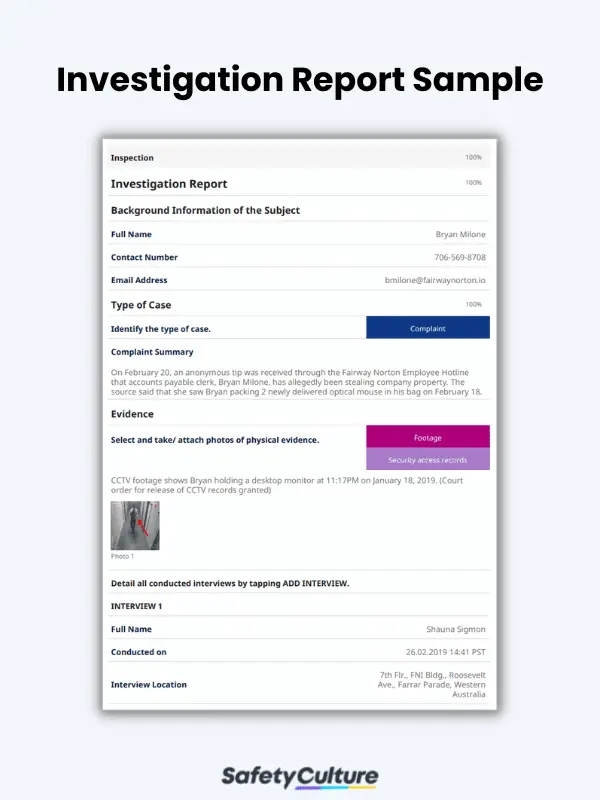What is an Investigation Report?
An investigation report is a document that details the findings of an investigation as soon as a formal complaint is filed or an incident occurs. Also called an investigation summary report, this is where investigators record the issues of the matter, analyze the evidence, and formulate a concise but detailed conclusion. It is impartial and based on evidence, not on the opinions of an investigator or the parties involved.
How To Write An Investigation Report (with Examples)
What is investigative report writing anyway? An investigation is a step-by-step method for determining facts about an issue or incident in public or workplace settings. Without proper documentation via an official investigative report, however, one cannot present a clear picture of what happened. To ensure that all facts, testimonials, and evidence are collated for later analysis, an investigator should follow three essential steps.
Below is an actual investigation report example that shows and follows how to write an investigative report with three basic steps:
Step 1: Start With What You Know
The investigator should record the information about the subject (respondent or accused person) and the details of the complaint. Take note of specific descriptions such as times, dates, and locations to further clarify the issues of the matter.
Example: Alicia Bates alleges that Clark Nichols, a payroll clerk, has been falsifying his timesheet. Alicia says that she noticed a discrepancy when she reviewed the timesheets in preparation for the January 2019 payroll. On February 4, Alicia required Clark to explain in writing said discrepancies and saw that it did not align with the hours that he reported.
Step 2: Make Sense of What You Have
Evidence analysis can substantiate claims from either party. The investigator should gather physical evidence such as footage, email records, documents or papers, physical objects, etc. and document investigative interviews. These should then be analyzed to identify the relevant facts, assess the credibility of disputed facts, and dismiss irrelevant facts.
Example: CCTV footage shows that Clark was not in the office during the times he reported in his timesheet. I interviewed Clark on February 11, and he denied the allegations. He said that he would start as early as 4 AM sometimes and go to a local fast food chain for breakfast by 8 AM, which he argued explained his absence. Clark sought the assistance of a fellow payroll clerk, Alfred Mariano, to cover up his conduct. I interviewed Alfred on February 12, and he said that he usually sees Clark in the office after their lunch break.
Step 3: Formulate a Conclusion
State the conclusion reached based on the facts and supporting evidence. At the end of the report, the investigator should indicate whether the matter is substantiated, unsubstantiated, or inconclusive.
Example: There is clear evidence to prove that the subject falsified his timesheet, a violation of the Company Code of Conduct Section 3. Therefore, the complaint is substantiated.
What to Include in an Investigation Report?
Investigation reports can differ based on the industry of a business. There are, however, certain important elements that should always be included in a comprehensive report. The basic parts of an investigative report format include the background information of the case, names and titles of investigators, organization name, type of case (complaint, violation, incident, accident), case summary, proof or evidence, interview (as needed), case conclusion, and required signatures.
How to Use an Investigation Report Template
The accuracy of an investigation report lies in its structure. The structure allows reports to be consistent and reduces the time and effort spent in preparing and writing the report. Additionally, it would also be ideal if investigation reports are performed in a tool that allows easy collaboration, documentation in one safe location, and real-time report generation.
Steps to Using the Investigation Report Template
An effective investigation report follow these steps:
- Ask for basic information – This is the backbone of the investigation report—information including name, subject, contact details, the party conducting the investigation, the assigned investigator’s name, case number, and the dates that the case was created and completed (if applicable), should be added.
- Specify the type of case – Before proceeding with the report, identify the type of case to be investigated. It can be a case of a complaint, violation, incident, or an accident—specifying this would help in collecting the right data needed for a cohesive report.
- Gather supporting details – Provide a summary of the complaint by detailing initially known facts. It will also be helpful to include who was involved in the case and how the report was received.
- Provide evidence – Strengthen the report by attaching a photo of tangible evidence. This evidence can be in the form of footage, email records, security records, computer login records, documents, and physical objects, among others. It will also be ideal to conduct interviews with people involved or those who witnessed the incident firsthand.
- Arrive with a conclusion – After going through case notes, and analyzing claims and evidence, the investigator will then formulate a conclusion and indicate whether the case is substantiated, unsubstantiated, or inconclusive.
Investigation Report Example
To give you a better idea of what an investigation report looks like, below is a final investigation report sample we’ve created using an investigation report template. Preview and download an Investigation Report Template here.
FAQs about Investigation Reports
An investigative report should include all the pertinent information about the incident along with all the evidence gathered to support the inquiry. This can consist of the type of case (e.g., complaint, violation, incident, or accident), a summary of details related to the case which will help provide better context on the issue, evidence such as photos, footage, email records, interview statements of people involved, and other substantial documents should be included to strengthen the report, and lastly, the conclusion which states the result of the findings from the case.
An investigator will be assigned either in-house or externally to look into the details of the incident. The investigator will be responsible in exploring the details of the allegations, examining the evidence, and formulating a conclusion. He/she will then write the report and present his/her findings to the stakeholders.
An investigation report is an excellent way of presenting the information and evidence gathered during the investigation. Documenting investigations ensures a reliable account of the event.




